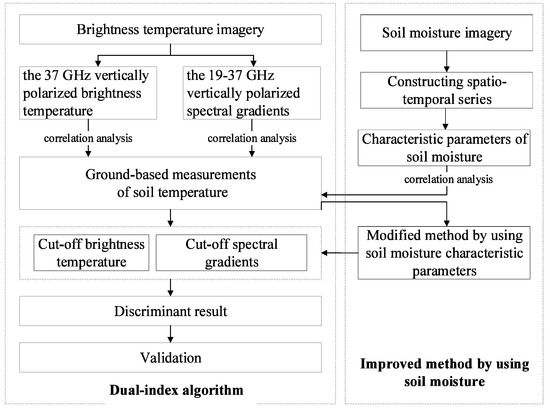An Improved Algorithm for Discriminating Soil Freezing and Thawing Using AMSR-E and AMSR2 Soil Moisture Products
Abstract
1. Introduction
2. Materials and Methods
2.1. Methodology
2.2. Materials
2.2.1. Ground-Based Measurements
2.2.2. Datasets of Microwave Satellite Products
2.3. DIA
2.4. Soil Moisture Characteristics
2.5. Soil Moisture Characteristic Parameter Extraction
2.6. Improvement of the DIA by Using LVSM
3. Results
3.1. Performance Comparisons of the Improved Algorithm with Original DIA over the Experiment Site
3.2. Performance of the Improved Algorithm as Compared with the DIA over the Whole Territory of China
4. Discussion
5. Conclusions
Author Contributions
Funding
Acknowledgments
Conflicts of Interest
References
- Lachenbruch, A.H.; Marshall, B.V. Changing Climate: Geothermal Evidence from Permafrost in the Alaskan Arctic. Science 1986, 234, 689–696. [Google Scholar] [CrossRef] [PubMed]
- Zhang, T.; Armstrong, R.L. Soil freeze/thaw cycles over snow-free land detected by passive microwave remote sensing. Geophys. Res. Lett. 2001, 28, 76–766. [Google Scholar] [CrossRef]
- Smith, N.V.; Saatchi, S.S.; Randerson, J.T. Trends in high northern latitude soil freeze and thaw cycles from 1988 to 2002. J. Geophys. Res. Atmos. 2004, 109, D12101. [Google Scholar] [CrossRef]
- Jin, M.S.; Mullens, T. A Study of the Relations between Soil Moisture, Soil Temperatures and Surface Temperatures Using ARM Observations and Offline CLM4 Simulations. Climate 2014, 2, 279–295. [Google Scholar] [CrossRef]
- Zuemdorfer, B.W.; England, A.W.; Dobson, M.C.; Ulaby, F.T. Mapping freeze/thaw boundaries with SMMR data. Agric. For. Meteorol. 1990, 52, 199–225. [Google Scholar] [CrossRef]
- Judge, J.; Galantowicz, J.F.; England, A.W.; Dahl, P. Freeze/thaw classification for prairie soils using SSM/I radiobrightnesses. IEEE Trans. Geosci. Remote Sens. 1997, 35, 827–832. [Google Scholar] [CrossRef]
- Goulden, M.L.; Wofsy, S.C.; Harden, J.W.; Trumbore, S.E.; Crill, P.M.; Gower, S.T.; Fries, T.; Daube, B.C.; Fan, S.M.; Sutton, D.J.; et al. Sensitivity of boreal forest carbon balance to soil thaw. Science 1998, 279, 214–217. [Google Scholar] [CrossRef] [PubMed]
- Cheng, G.D.; Jin, H.J. Groundwater in the permafrost regions on the Qinghai-Tibet Plateau and it changes. Hydrogeol. Eng. Geol. 2013, 40, 1–11. [Google Scholar]
- Yao, T.D.; Qin, D.H.; Shen, Y.P.; Zhao, L.; Wang, N.L. Cryospheric changes and their impacts on regional water cycle and ecological conditions in the Qinghai-Tibetan Plateau. Chin. J. Nat. 2013, 35, 179–186. [Google Scholar]
- Grody, N.C. Classification of snow cover and precipitation using the special sensor microwave imager. J. Geophys. Res. Atmos. 1991, 96, 7423–7435. [Google Scholar] [CrossRef]
- Ulaby, F.T.; Kouyate, F.; Brisco, B.; Williams TH, L. Textural Information in SAR Images. IEEE Trans. Geosci. Remote Sens. 1986, 24, 235–245. [Google Scholar] [CrossRef]
- England, A.W. Radio brightness of diurnally heated, freezing soil. IEEE Trans. Geosci. Remote Sens. 1990, 28, 464–476. [Google Scholar] [CrossRef]
- Kimball, J.S.; Mcdonald, K.C.; Keyser, A.R.; Frolking, S.; Running, S.W. Application of the NASA Scatterometer (NSCAT) for Determining the Daily Frozen and Nonfrozen Landscape of Alaska. Remote Sens. Environ. 2001, 75, 113–126. [Google Scholar] [CrossRef]
- Jin, R.; Xin, L.I. A Review on the Algorithms of Frozen/Thaw Boundary Detection by Using Passive Microwave Remote Sensing. Remote Sens. Technol. Appl. 2002, 17, 370–375. [Google Scholar]
- Du, J.; Kimball, J.S.; Azarderakhsh, M.; Dunbar, R.S.; Moghaddam, M.; Mcdonald, K. Classification of Alaska Spring Thaw Characteristics Using Satellite L-Band Radar Remote Sensing. IEEE Trans. Geosci. Remote Sens. 2014, 53, 542–556. [Google Scholar] [CrossRef]
- Mcdonald, K.C.; Kimball, J.S.; Njoku, E.; Zimmermann, R.; Zhao, M. Variability in springtime thaw in the terrestrial high latitudes: Monitoring a major control on the biospheric assimilation of atmospheric CO2 with space borne microwave remote sensing. Earth Interact. 2004, 8. [Google Scholar] [CrossRef]
- Wismann, V. Monitoring of seasonal thawing in Siberia with ERS scatterometer data. IEEE Trans. Geosci. Remote Sens. 2000, 38, 1804–1809. [Google Scholar] [CrossRef]
- Mcdonald, K.C.; Kimball, J.S. Estimation of surface freeze–thaw states using microwave sensors. In Encyclopedia of Hydrological Sciences; John Wiley & Sons, Ltd.: Hoboken, NJ, USA, 2006. [Google Scholar]
- Chai, L.N.; Zhang, L.X.; Zhang, Y.Y.; Hao, Z.G.; Zhang, L.M.; Zhao, J.P. Comparison of the classification accuracy of three soil freeze–thaw discrimination algorithms in China using SSMIS and AMSR-E passive microwave imagery. Int. J. Remote Sens. 2014, 35, 7631–7649. [Google Scholar] [CrossRef]
- Han, M.L.; Yang, K.; Qin, J.; Jin, R.; Ma, Y.M.; Wen, J.; Cheng, Y.Y.; Zhao, L.; Zhu, L.; Tang, W.J. An Algorithm Based on the Standard Deviation of Passive Microwave Brightness Temperatures for Monitoring Soil Surface Freeze/Thaw State on the Tibetan Plateau. IEEE Trans. Geosci. Remote Sens. 2015, 53, 2775–2783. [Google Scholar] [CrossRef]
- Zuemdorfer, B.; England, A.W. Radio brightness decision criteria for freeze/thaw boundaries. IEEE Trans. Geosci. Remote Sens. 1992, 30, 89–102. [Google Scholar] [CrossRef]
- Wegmüller, U. The effect of freezing and thawing on the microwave signatures of bare soil. Remote Sens. Environ. 1990, 33, 123–135. [Google Scholar] [CrossRef]
- Zuemdorfer, B.; England, A.W.; Wakefield, G.H. The radio brightness of freezing terrain. In Proceedings of the 12th Canadian Symposium on Remote Sensing International Conference, Vancouver, BC, Canada, 10–14 July 1989. [Google Scholar]
- Cao, M.S.; Zhang, T.J. Monitoring terrain soil freeze/ thaw condition on Qinghai plateau in spring and autumn using microwave remote sensing. J. Remote Sens. 1997, 1, 139–144. [Google Scholar]
- Zhang, T.; Jin, R.; Gao, F. Overview of the Satellite Remote Sensing of Frozen Ground: Passive Microwave Sensors. Adv. Earth Sci. 2009, 24, 1073–1083. [Google Scholar]
- Jin, R.; Li, X.; Tao, C. A decision tree algorithm for surface soil freeze/thaw classification over China using SSM/I brightness temperature. Remote Sens. Environ. 2009, 113, 2651–2660. [Google Scholar] [CrossRef]
- Zhao, T.J.; Zhang, L.X.; Jiang, L.M.; Zhao, S.J.; Chai, L.N.; Jin, R. A new soil freeze/thaw discriminant algorithm using AMSR-E passive microwave imagery. Hydrol. Processes 2011, 25, 1704–1716. [Google Scholar] [CrossRef]
- Kou, X.K.; Jiang, L.M.; Yan, S.; Zhao, T.J.; Lu, H.; Cui, H.Z. Detection of land surface freeze-thaw status on the Tibetan Plateau using passive microwave and thermal infrared remote sensing data. Remote Sens. Environ. 2017, 199, 291–301. [Google Scholar] [CrossRef]
- Kim, Y.; Kimball, J.S.; Mcdonald, K.C.; Glassy, J. Developing a Global Data Record of Daily Landscape Freeze/Thaw Status Using Satellite Passive Microwave Remote Sensing. IEEE Trans. Geosci. Remote Sens. 2011, 49, 949–960. [Google Scholar] [CrossRef]
- Park, S.E.; Bartsch, A.; Sabel, D.O.; Wagner, W.; Naeimi, V.; Yamaguchi, Y. Monitoring freeze/thaw cycles using ENVISAT ASAR Global Mode. Remote Sens. Environ. 2011, 115, 3457–3467. [Google Scholar] [CrossRef]
- Rautiainen, K.; Lemmetyinen, J.; Schwank, M.; Kontu, A.; Menard, C.B.; Matzler, C.; Drusch, M.; Wiesmann, A.; Ikonen, J.; Pulliainen, J. Detection of soil freezing from L-band passive microwave observations. Remote Sens. Environ. 2014, 147, 206–218. [Google Scholar] [CrossRef]
- Roy, A.; Royer, A.; Derksen, C.; Brucker, L.; Langlois, A.; Mialon, A.; Kerr, Y.H. Evaluation of Spaceborne L-Band Radiometer Measurements for Terrestrial Freeze/Thaw Retrievals in Canada. IEEE J. Sel. Top. Appl. Earth Obs. Remote Sens. 2015, 8, 4442–4459. [Google Scholar] [CrossRef]
- Rautiainen, K.; Parkkinen, T.; Lemmetyinen, J.; Schwank, M.; Wiesmann, A.; Ikonen, J.; Derksen, C.; Davydov, S.; Davydova, A.; Boike, J.; et al. SMOS prototype algorithm for detecting autumn soil freezing. Remote Sens. Environ. 2016, 180. [Google Scholar] [CrossRef]
- Brocca, L.; Hasenauer, S.; Lacava, T.; Melone, F.; Moramarco, T.; Wagner, W.; Dorigo, W.; Matgen, P.; Martínez-Fernández, J.; Llorens, P.; et al. Soil moisture estimation through ASCAT and AMSR-E sensors: An intercomparison and validation study across Europe. Remote Sens. Environ. 2011, 115, 3390–3408. [Google Scholar] [CrossRef]
- Albergel, C.; Zakharova, E.; Calvet, J.C.; Zribi, M. A first assessment of the SMOS data in southwestern France using in situ, airborne and model soil moisture estimates. Remote Sens. Environ. 2011, 115, 2718–2728. [Google Scholar] [CrossRef]
- Yaari, A.; Wigneron, J.P.; Ducharne, A.; Kerrc, Y.; Wagnere, W.; Reichled, R.; Lannoyd, G.D.; Bitarc, A.A.; Dorigoe, W.; Parrensc, M.; et al. Compared performances of microwave passive soil moisture retrievals (SMOS) and active soil moisture retrievals (ASCAT) using land surface model estimates (MERRA-LAND). In Proceedings of the International Geoscience and Remote Sensing Symposium (IGARSS), Quebec City, QC, Canada, 13–18 July 2014. [Google Scholar]
- Zhong, A.F.; Wang, A.Q.; Li, J.W.; Xu, T.B.; Meng, D.; Ke, Y.H.; Li, X.J.; Chen, Y. Downscaling of passive microwave soil moisture retrievals based on spectral analysis. Int. J. Remote Sens. 2018, 39, 50–67. [Google Scholar] [CrossRef]
- Gonzalez, R.C.; Woods, R.E. Digital Image Process; Addison-Wesley Longman Publishing Co., Inc.: Boston, MA, USA, 1992. [Google Scholar]
- Ajafernandez, S.; Estepar, R.S.; Alberolalopez, C.; Westin, C. Image Quality Assessment based on Local Variance. In Proceedings of the Annual International Conference of the IEEE Engineering in Medicine and Biology Society, New York City, NY, USA, 30 August–3 September 2006. [Google Scholar]
- Wang, Y.Q.; Liu, W.Y.; Yong, W. Image quality assessment based on local variance and structure similarity. J. Optoelectron. Laser 2008, 19, 1546–1553. [Google Scholar]
- Yang, K.; Qin, J.; Zhao, L.; Cheng, Y.Y.; Tang, W.J.; Han, M.L.; Zhu, L.; Chen, Z.Q.; Lv, N.; Ding, B.H.; et al. A Multi-Scale Soil Moisture and Freeze-Thaw Monitoring Network on the Third Pole. Bull. Am. Meteorol. Soc. 2013, 94, 1907–1916. [Google Scholar] [CrossRef]
- Qin, J.; Yang, K.; Lu, N.; Cheng, Y.Y.; Zhao, L.; Han, M.L. Spatial upscaling of in-situ soil moisture measurements based on MODIS-derived apparent thermal inertia. Remote Sens. Environ. 2013, 138, 1–9. [Google Scholar] [CrossRef]
- Njoku, E.G.; Chan, T.; Crosson, W.; Limaye, A. Evaluation of the AMSR-E Data Calibration Over Land. Ital. J. Remote Sens. 2004, 29, 19–37. [Google Scholar]
- Cho, E.; Su, C.H.; Ryu, D.; Choi, M. Does AMSR2 produce better soil moisture retrievals than AMSR-E over Australia? Remote Sens. Environ. 2017, 188, 95–105. [Google Scholar] [CrossRef]
- Njoku, E.G.; Jackson, T.J.; Lakshmi, V.; Chan, T.K.; Nghiem, S.V. Soil moisture retrieval from AMSR-E. IEEE Trans. Geosci. Remote Sens. 2003, 41, 215–229. [Google Scholar] [CrossRef]
- Yang, X.H.; Zaxiyangzong; Zhouga; Bianbaciren. Relation of vegetation coverage to meteorological conditions in the Naqu area of Tibet. Acta Pratacult. Sin. 2008, 17, 102–109. [Google Scholar]
- Fujii, H.; Koike, T.; Imaoka, K. Improvement of the AMSR-E algorithm for soil moisture estimation by introducing a fractional vegetation coverage dataset derived from MODIS data. J. Remote Sens. Soc. Japan 2009, 29, 282–292. [Google Scholar]
- Zeng, J.Y.; Li, Z.; Chen, Q.; Bi, H.Y.; Qiu, J.X.; Zou, P.F. Evaluation of remotely sensed and reanalysis soil moisture products over the Tibetan Plateau using in-situ observations. Remote Sens. Environ. 2015, 163, 91–110. [Google Scholar] [CrossRef]
- Seneviratne, S.I.; Corti, T.; Davin, E.L.; Hirschi, M.; Jaeger, E.B.; Lehner, L.; Orlowsky, B.; Teuling, A. Investigating soil moisture–climate interactions in a changing climate: A review. Earth Sci. Rev. 2010, 99, 125–161. [Google Scholar] [CrossRef]
- Zhao, G.; Fan, T.L.; Li, S.Z.; Zhang, J.J.; Wang, Y.; Dang, Y.; Wang, L. Soil moisture dynamics of apple orchard in Loess Plateau dryland. J. Appl. Ecol. 2015, 26, 1199–1204. [Google Scholar]
- Malbéteau, Y.; Merlin, O.; Molero, B.; Rüdiger, C.; Bacon, S. DisPATCh as a tool to evaluate coarse-scale remotely sensed soil moisture using localized in situ measurements: Application to SMOS and AMSR-E data in Southeastern Australia. Int. J. Appl. Earth Obs. Geoinf. 2016, 45, 221–234. [Google Scholar] [CrossRef]
- Aja-Fernández, S.; Estépar, R.S.; Alberola-López, C.; Westin, C.F. Image Quality Assessment based on Local Variance. In Proceedings of the 28th IEEE EMBS Annual International Conference, New York City, NY, USA, 30 August–3 September 2006. [Google Scholar]
- Zhou, Y.W.; Guo, D.X.; Qiu, G.Q.; Cheng, G.D.; Li, S.D. Geocryology in China Beijing; Science Press in Chinese: Beijing, China, 2000. [Google Scholar]
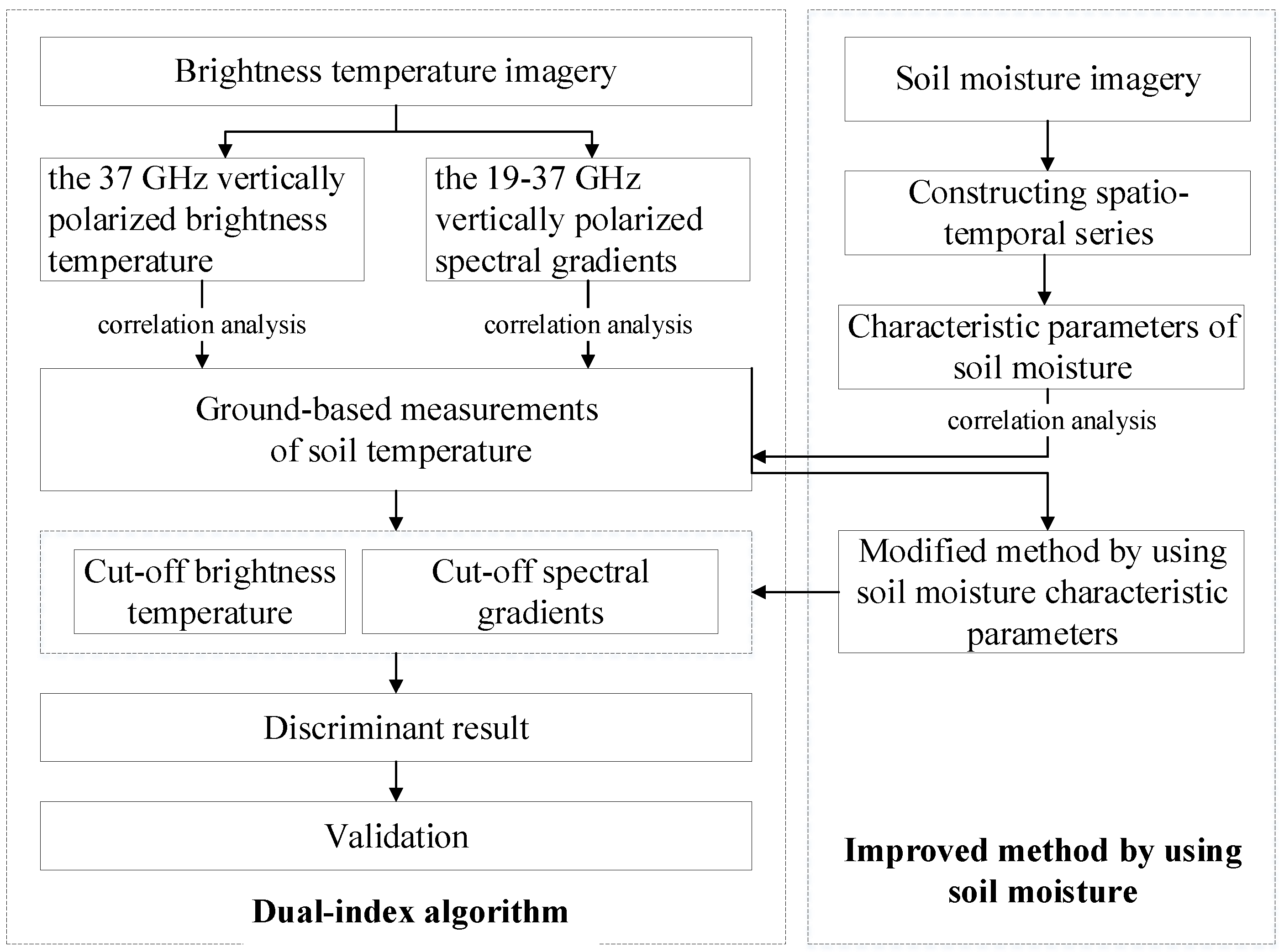

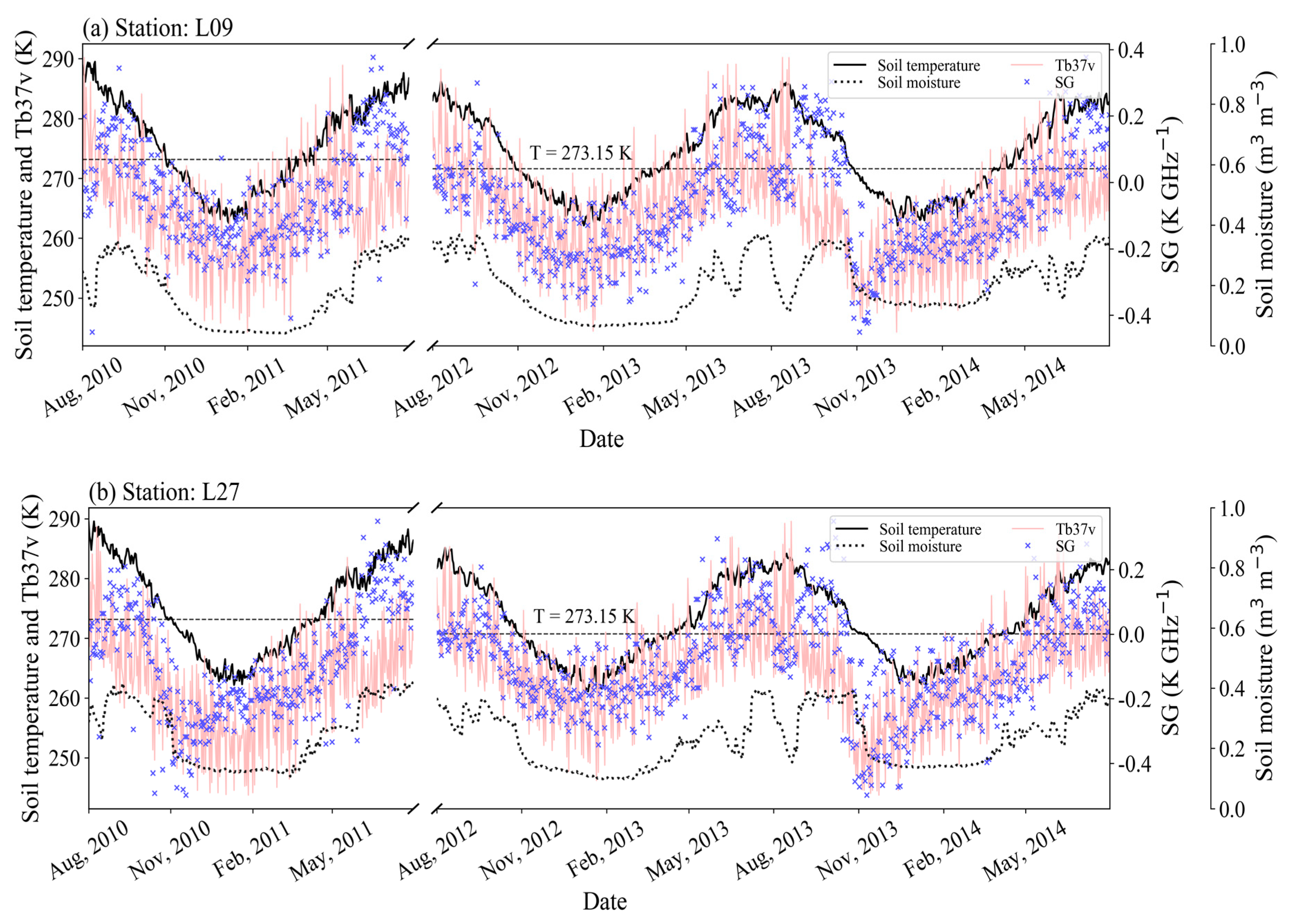
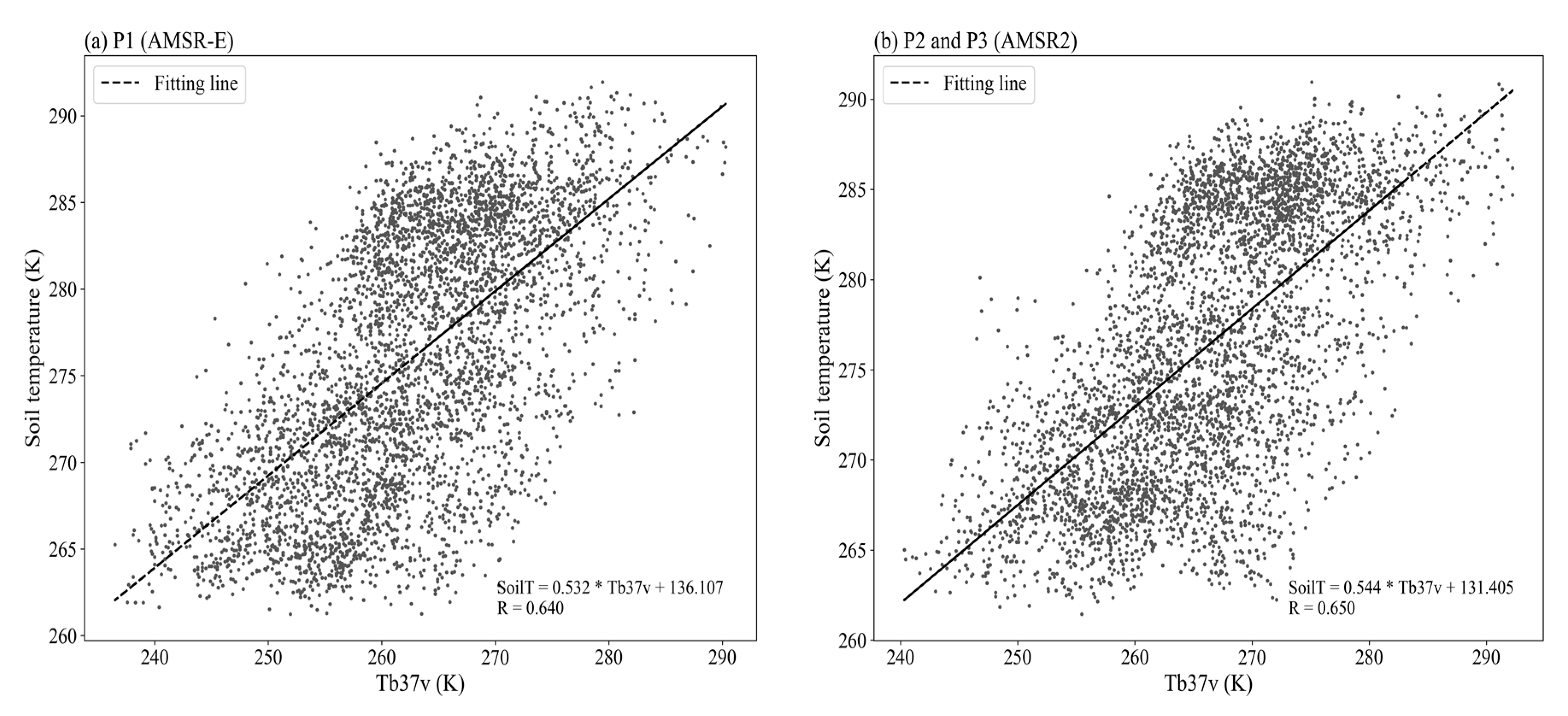

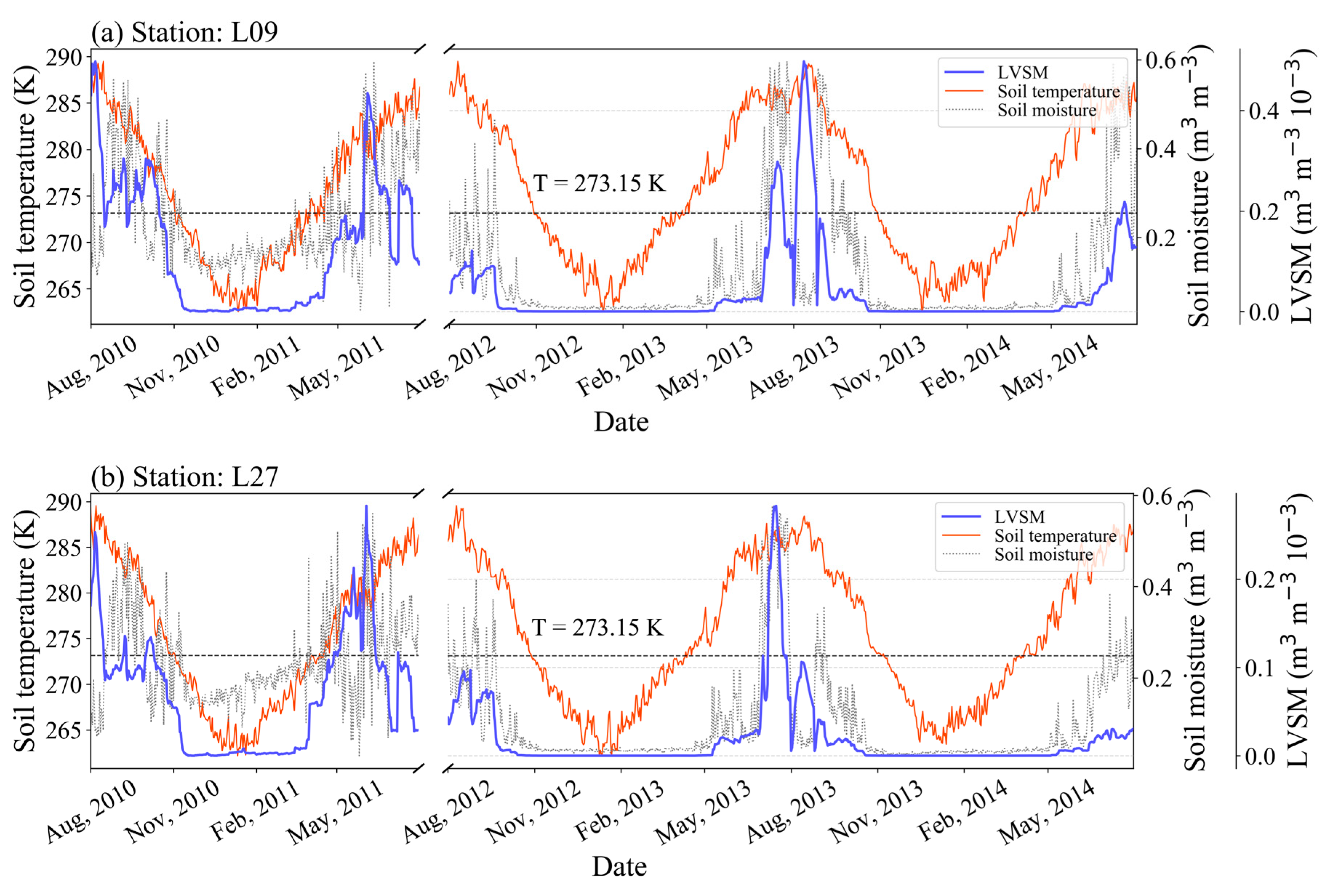
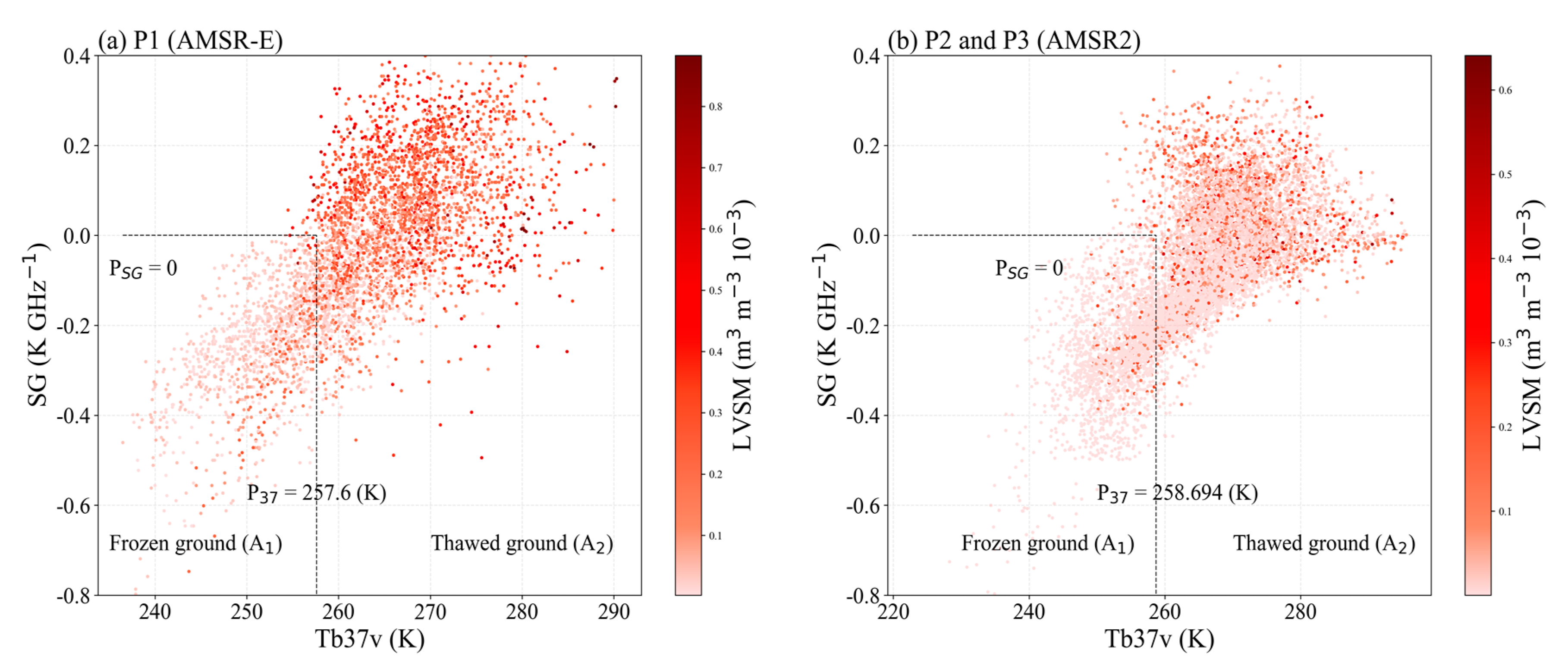
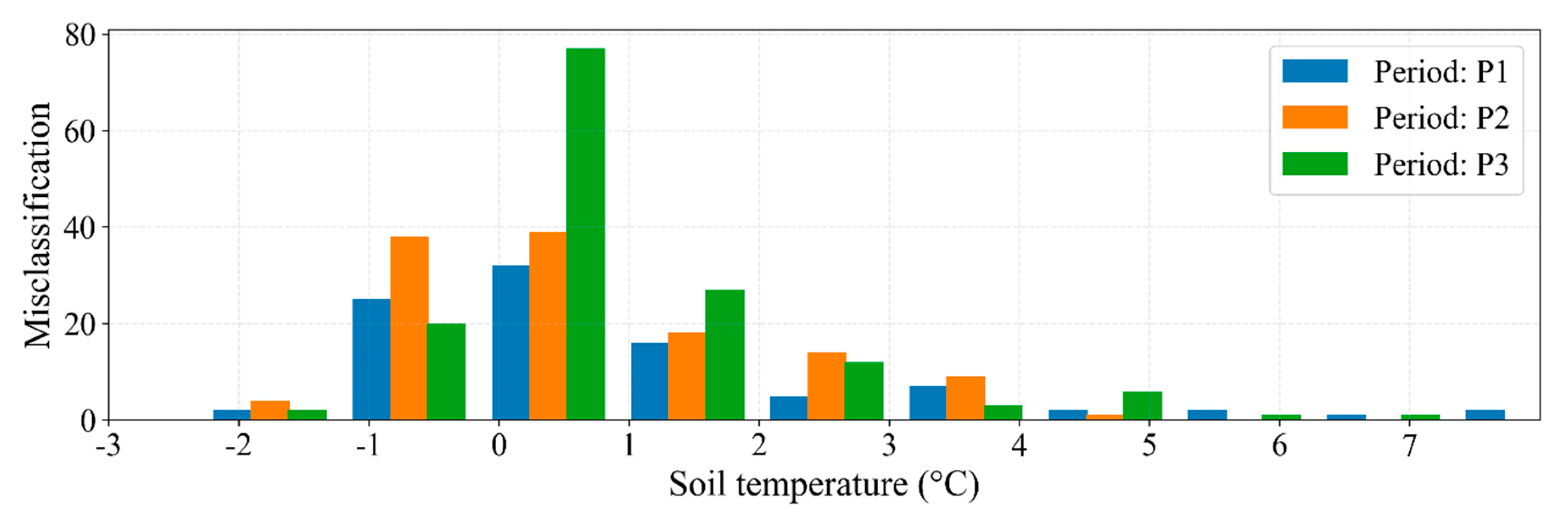
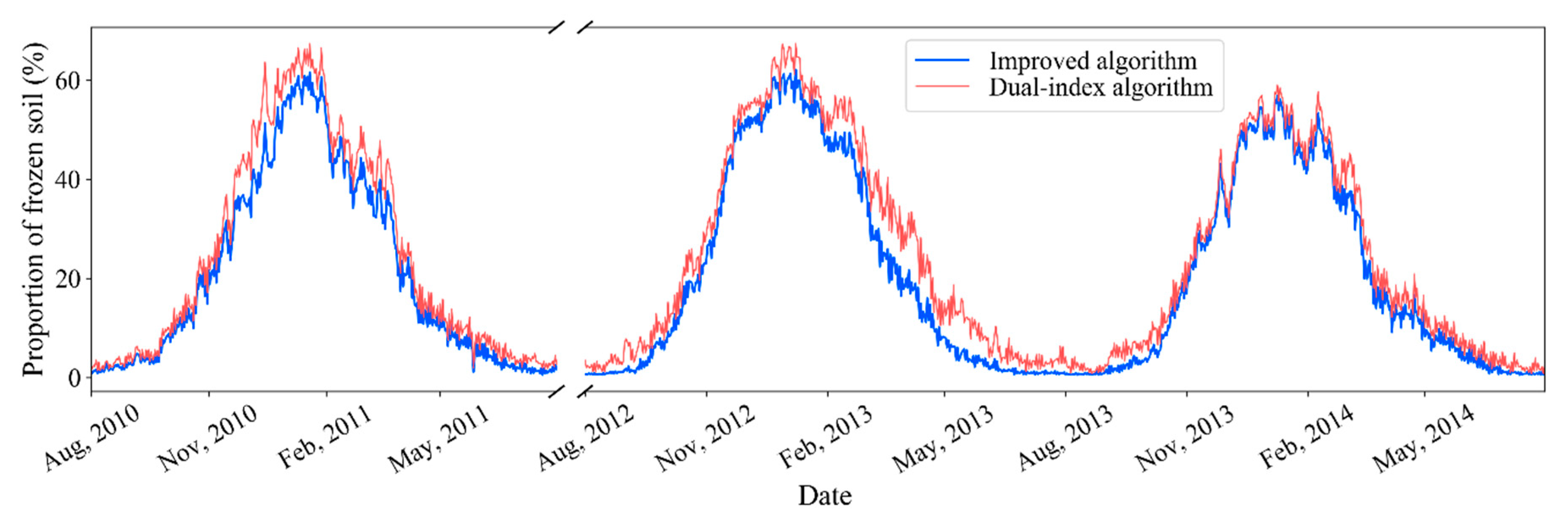
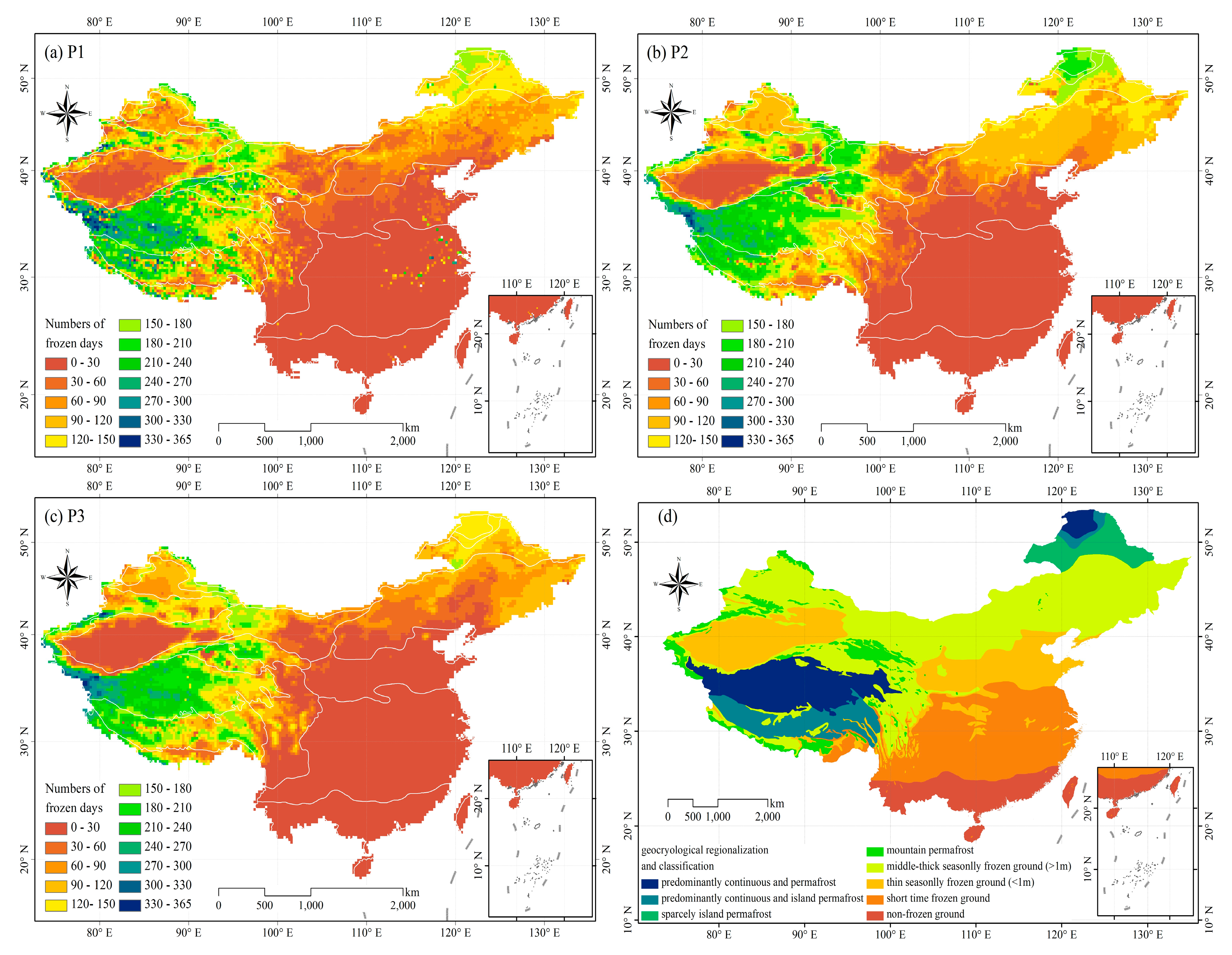
| Data Type | Data | Spatial Resolution | Temporal Resolution | Time Range | Application |
|---|---|---|---|---|---|
| AMSR-E | SM 1 | 0.25° | Daily | From 1 August 2010, to 31 July 2011 (P1) | Basic data for soil moisture characteristic parameters extraction |
| Tb19v 2 | 0.25° | Daily | Original data for freeze and thaw discrimination | ||
| Tb37v 3 | 0.25° | Daily | Original data for freeze and thaw discrimination | ||
| AMSR2 | SM | 0.25° | Daily | From 1 August 2012, to 31 July 2013 (P2) and from 1 August 2013, to 31 July 2014 (P3) | Basic data for soil moisture characteristic parameters extraction |
| Tb19v | 0.25° | Daily | Original data for freeze and thaw discrimination | ||
| Tb37v | 0.25° | Daily | Original data for freeze and thaw discrimination |
| Study Period | Sta. 1 | Initial Days (Date/DOY) of Soil Freezing | Initial Days (Date/DOY) of Soil Thawing | ||||
|---|---|---|---|---|---|---|---|
| Improved Algorithm | DIA | SMTMN obs. 2 | Improved Algorithm | DIA | SMTMN obs. | ||
| P1 | L1 | 03 Nov/307 | 12 Oct/285 | 02 Nov/306 | 29 Mar/088 | 29 Mar/088 | 01 Apr/091 |
| L9 | 03 Nov/307 | 12 Oct/285 | 03 Nov/307 | 29 Mar/088 | 29 Mar/088 | 01 Apr/091 | |
| L11 | 01 Nov/305 | 12 Oct/285 | 03 Nov/307 | 29 Mar/088 | 29 Mar/088 | 19 Mar/078 | |
| L14 | 03 Nov/307 | 12 Oct/285 | 04 Nov/308 | 24 Mar/083 | 24 Mar/083 | 19 Mar/078 | |
| L19 | 28 Oct/301 | 05 Oct/278 | 04 Nov/308 | 02 Apr/092 | 16 May/136 | 31 Mar/090 | |
| L23 | 12 Sep/255 | 25 Aug/237 | 05 Nov/309 | 02 Apr/092 | 17 Jun/168 | 16 Mar/075 | |
| L26 | 10 Sep/253 | 10 Sep/253 | 04 Nov/308 | 18 Apr/108 | 04 May/124 | 18 Apr/108 | |
| L27 | 28 Oct/301 | 12 Oct/285 | 29 Oct/302 | 24 Mar/083 | 24 Mar/083 | 12 Apr/102 | |
| L30 | 28 Oct/301 | 12 Oct/285 | 04 Nov/308 | 02 Apr/092 | 04 May/124 | 25 Mar/084 | |
| L32 | 04 Nov/308 | 12 Oct/285 | 04 Nov/308 | 24 Mar/083 | 24 Mar/083 | 19 Mar/078 | |
| L35 | 28 Oct/301 | 12 Oct/285 | 04 Nov/308 | 29 Mar/088 | 29 Mar/088 | 27 Mar/086 | |
| L37 | 10 Sep/253 | 08 Sep/251 | 04 Nov/308 | 09 May/129 | 17 Jun/168 | 17 Mar/076 | |
| L1 | 02 Nov/307 | 26 Oct/300 | 01 Nov/306 | 19 Apr/109 | 19 Apr/109 | 09 Apr/099 | |
| P2 | L9 | 02 Nov/307 | 16 Sep/260 | 30 Oct/304 | 19 Apr/109 | 19 Apr/109 | 29 Mar/088 |
| L11 | 26 Oct/300 | 08 Oct/282 | 02 Nov/307 | 19 Apr/109 | 19 Apr/109 | 15 Mar/074 | |
| L14 | 02 Nov/307 | 10 Oct/284 | 06 Nov/311 | 03 Apr/093 | 03 Apr/093 | 15 Mar/074 | |
| L19 | 28 Oct/302 | 12 Oct/286 | 07 Nov/312 | 05 Apr/095 | 07 May/127 | 22 Mar/081 | |
| L23 | 24 Oct/298 | 21 Aug/234 | 30 Oct/304 | 12 Apr/102 | 25 May/145 | 10 Apr/100 | |
| L26 | 24 Oct/298 | 10 Oct/284 | 03 Nov/308 | 19 Apr/109 | 19 Apr/109 | 10 Apr/100 | |
| L27 | 02 Nov/307 | 12 Oct/286 | 29 Oct/303 | 03 Apr/093 | 03 Apr/093 | 13 Apr/103 | |
| L30 | 28 Oct/302 | 10 Oct/284 | 30 Oct/304 | 03 Apr/093 | 03 Apr/093 | 14 Mar/073 | |
| L32 | 25 Oct/299 | 19 Oct/293 | 30 Oct/304 | 22 Mar/081 | 19 Apr/109 | 15 Mar/074 | |
| L35 | 25 Oct/299 | 08 Oct/282 | 09 Nov/314 | 19 Apr/109 | 5 May/125 | 29 Mar/088 | |
| L37 | 22 Oct/296 | 21 Aug/234 | 30 Oct/304 | 20 Apr/110 | 28 May/148 | 14 Mar/073 | |
| P3 | L1 | 26 Oct/299 | 04 Oct/277 | 31 Oct/304 | 03 May/123 | 24 May/083 | 06 Apr/096 |
| L9 | 02 Nov/306 | 20 Oct/293 | 30 Oct/303 | 30 Mar/089 | 30 Mar/089 | 31 Mar/090 | |
| L11 | 20 Oct/293 | 06 Oct/279 | 31 Oct/302 | 03 May/123 | 03 May/123 | 26 Mar/085 | |
| L14 | 22 Oct/295 | 22 Oct/295 | 31 Oct/302 | 23 Mar/082 | 23 Mar/082 | 27 Mar/086 | |
| L19 | 22 Oct/295 | 22 Oct/295 | 03 Nov/307 | 10 Feb/041 | 10 Feb/041 | 28 Mar/087 | |
| L23 | 22 Oct/295 | 15 Oct/288 | 08 Nov/312 | 25 Mar/084 | 25 Mar/084 | 06 Apr/096 | |
| L26 | 20 Oct/293 | 15 Oct/288 | 05 Nov/309 | 23 Mar/082 | 23 Mar/082 | 06 Apr/096 | |
| L27 | 20 Oct/293 | 15 Oct/288 | 08 Nov/312 | 23 Mar/082 | 23 Mar/082 | 06 Apr/096 | |
| L30 | 22 Oct/293 | 22 Oct/295 | 31 Oct/304 | 10 Feb/041 | 10 Feb/041 | 28 Mar/087 | |
| L32 | 20 Oct/293 | 20 Oct/293 | 08 Nov/312 | 26 Feb/057 | 26 Feb/057 | 26 Mar/085 | |
| L35 | 20 Oct/293 | 06 Oct/279 | 04 Nov/308 | 03 May/123 | 03 May/123 | 29 Mar/088 | |
| L37 | 20 Oct/293 | 04 Oct/277 | 31 Oct/304 | 08 Apr/098 | 03 May/123 | 17 Mar/076 | |
| Study Period | Sta. | DIA | Improved Algorithm | ||||
|---|---|---|---|---|---|---|---|
| Validation | Incorrect Discrimination | Accuracy (%) | Validation | Incorrect Discrimination | Accuracy (%) | ||
| P1 | L1 | 90 | 15 | 83.3 | 90 | 8 | 91.1 |
| L9 | 90 | 9 | 90.0 | 90 | 4 | 95.6 | |
| L11 | 90 | 8 | 91.1 | 90 | 3 | 96.7 | |
| L14 | 90 | 7 | 94.4 | 90 | 2 | 97.8 | |
| L19 | 90 | 20 | 77.8 | 90 | 4 | 95.6 | |
| L23 | 90 | 27 | 70.0 | 90 | 12 | 86.7 | |
| L26 | 90 | 24 | 73.3 | 90 | 15 | 83.3 | |
| L27 | 90 | 22 | 75.6 | 90 | 14 | 84.4 | |
| L30 | 90 | 14 | 84.4 | 90 | 4 | 95.6 | |
| L32 | 90 | 3 | 96.7 | 90 | 1 | 98.9 | |
| L35 | 90 | 4 | 95.6 | 90 | 1 | 98.9 | |
| L37 | 90 | 30 | 66.7 | 90 | 26 | 71.1 | |
| Total | 1080 | 183 | 83.1 | 1080 | 94 | 91.3 | |
| P2, P3 | L1 | 180 | 42 | 76.7 | 180 | 29 | 83.9 |
| L9 | 180 | 23 | 87.2 | 180 | 15 | 91.7 | |
| L11 | 180 | 28 | 84.5 | 180 | 16 | 91.1 | |
| L14 | 180 | 12 | 93.3 | 180 | 11 | 93.9 | |
| L19 | 180 | 28 | 84.5 | 180 | 14 | 92.2 | |
| L23 | 180 | 41 | 77.3 | 180 | 25 | 86.2 | |
| L26 | 180 | 43 | 76.1 | 180 | 28 | 84. 5 | |
| L27 | 180 | 34 | 81.1 | 180 | 30 | 83.3 | |
| L30 | 180 | 26 | 85.6 | 180 | 21 | 88.4 | |
| L32 | 180 | 24 | 86.7 | 180 | 19 | 89.5 | |
| L35 | 180 | 38 | 78.9 | 180 | 23 | 87.2 | |
| L37 | 180 | 66 | 63.3 | 180 | 31 | 82.8 | |
| Total | 2160 | 405 | 81.3 | 2160 | 262 | 87.9 | |
| P1, P2 and P3 | Total | 3240 | 588 | 81.9 | 3240 | 356 | 89.0 |
© 2018 by the authors. Licensee MDPI, Basel, Switzerland. This article is an open access article distributed under the terms and conditions of the Creative Commons Attribution (CC BY) license (http://creativecommons.org/licenses/by/4.0/).
Share and Cite
Gao, H.; Zhang, W.; Chen, H. An Improved Algorithm for Discriminating Soil Freezing and Thawing Using AMSR-E and AMSR2 Soil Moisture Products. Remote Sens. 2018, 10, 1697. https://doi.org/10.3390/rs10111697
Gao H, Zhang W, Chen H. An Improved Algorithm for Discriminating Soil Freezing and Thawing Using AMSR-E and AMSR2 Soil Moisture Products. Remote Sensing. 2018; 10(11):1697. https://doi.org/10.3390/rs10111697
Chicago/Turabian StyleGao, Huiran, Wanchang Zhang, and Hao Chen. 2018. "An Improved Algorithm for Discriminating Soil Freezing and Thawing Using AMSR-E and AMSR2 Soil Moisture Products" Remote Sensing 10, no. 11: 1697. https://doi.org/10.3390/rs10111697
APA StyleGao, H., Zhang, W., & Chen, H. (2018). An Improved Algorithm for Discriminating Soil Freezing and Thawing Using AMSR-E and AMSR2 Soil Moisture Products. Remote Sensing, 10(11), 1697. https://doi.org/10.3390/rs10111697




